July 1, 2021
PUBLISHER’S CORNER
 By Eloise Graham
By Eloise Graham
Grasshoppers, Locusts, Crickets, Katydids or Cicadas…What is that night time noise?
Back in my misguided youth, right around five years of age, I saw many of those empty insect shells clinging to the bark of our locust tree. I was told they were locust shells (or at least that is the way I remember it) left behind when the locust emerged. I have a vague recollection of arguing with my parents when I found a couple of shells on the maple tree. Either that poor bug couldn’t find his home or we had a whole new species of “maple bugs.” It took seventy years for me to learn that locusts don’t emerge from shells, only the cicada does. So I had to do some research on these often mistaken night serenaders. What is the difference?
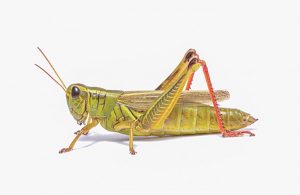 Grasshoppers – Grasshoppers are typically a ground-dwelling insect with powerful hind legs. This allows them to leap, or fly as it would seem, great distances. They are a plant eater, with a few species becoming pests of cereals, vegetables and pastures. They make their noise by rubbing a row of pegs on their hind legs against the edges of the forewings. This is called stridulation.
Grasshoppers – Grasshoppers are typically a ground-dwelling insect with powerful hind legs. This allows them to leap, or fly as it would seem, great distances. They are a plant eater, with a few species becoming pests of cereals, vegetables and pastures. They make their noise by rubbing a row of pegs on their hind legs against the edges of the forewings. This is called stridulation.
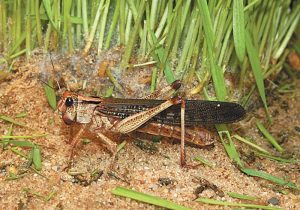 Locusts – Locusts are really grasshoppers, a large and mainly tropical grasshopper. Grasshoppers, at high population densities and under certain environmental conditions, can change coloring and behavior and form swarms. Under these circumstances, they are known as locusts. Their sound, as well as the stridulation, is the vibrating sound of so many in flight.
Locusts – Locusts are really grasshoppers, a large and mainly tropical grasshopper. Grasshoppers, at high population densities and under certain environmental conditions, can change coloring and behavior and form swarms. Under these circumstances, they are known as locusts. Their sound, as well as the stridulation, is the vibrating sound of so many in flight.
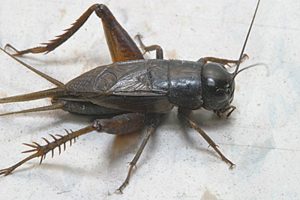 Crickets – Crickets are insects related to bush crickets (Katydids) and a distant cousin of the grasshopper. Crickets seem to “chirp.” Their stridulation comes from scissoring their wings together on their hind legs. Most predators of the cricket are active during daylight so that is why crickets chirp at night.
Crickets – Crickets are insects related to bush crickets (Katydids) and a distant cousin of the grasshopper. Crickets seem to “chirp.” Their stridulation comes from scissoring their wings together on their hind legs. Most predators of the cricket are active during daylight so that is why crickets chirp at night.
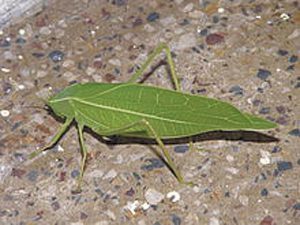 Katydids – Katydids are also called bush crickets. They are bright green in color, and sometimes they have almost an iridescent green leaf. Their stridulation is very rhythmic and changes pitch. Almost like eh, eh, id… eh, eh, id … eh, eh, id with the id being a staccato with a higher pitch. Hence, “ka, teh, did” sounding like katy did.
Katydids – Katydids are also called bush crickets. They are bright green in color, and sometimes they have almost an iridescent green leaf. Their stridulation is very rhythmic and changes pitch. Almost like eh, eh, id… eh, eh, id … eh, eh, id with the id being a staccato with a higher pitch. Hence, “ka, teh, did” sounding like katy did.
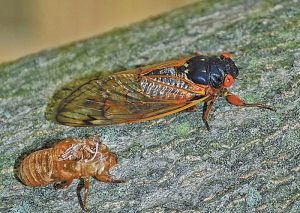 Cicadas – Perhaps the noisiest of the night serenaders are the cicadas. That are best known for the songs the male sing. It is a steady and loud vibration of a special organ called tymbal. These are membranes that vibrate very quickly when pulled by tiny muscles. We often hear that cicadas only come every 17 years. That is part fact, part fiction. The cycle of many cicadas, the hordes of cicadas, does occur every 15 to 18 years. Sometimes it depends on the weather conditions during that time frame. But there is also the annual cicada that appears every one to two years. They are not as plentiful as the other cicadas, but they can be just as loud and leave their abandoned shell on the trunk of trees. So if you see a cicada or shell on an “off” year, it really is a cicada and not a locust like I had spent most of my life believing. Glad I was able to correct a belief of my “misguided” youth.
Cicadas – Perhaps the noisiest of the night serenaders are the cicadas. That are best known for the songs the male sing. It is a steady and loud vibration of a special organ called tymbal. These are membranes that vibrate very quickly when pulled by tiny muscles. We often hear that cicadas only come every 17 years. That is part fact, part fiction. The cycle of many cicadas, the hordes of cicadas, does occur every 15 to 18 years. Sometimes it depends on the weather conditions during that time frame. But there is also the annual cicada that appears every one to two years. They are not as plentiful as the other cicadas, but they can be just as loud and leave their abandoned shell on the trunk of trees. So if you see a cicada or shell on an “off” year, it really is a cicada and not a locust like I had spent most of my life believing. Glad I was able to correct a belief of my “misguided” youth.


